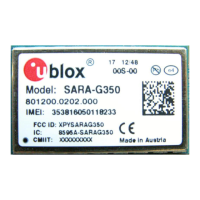SARA-G3 and SARA-U2 series - System Integration Manual
UBX-13000995 - R26 Design-in
Page 154 of 217
SARA-G340
SARA-G350
C1
C2
45
SPK_N
44
SPK_P
GND
49
MIC_P
GND
Analog IN (-)
Analog IN (+)
Analog OUT (-)
Analog OUT (+)
Audio Device
GND
GND
48
MIC_N
C3
C4
SARA-G340
SARA-G350
45
SPK_N
44
SPK_P
GND
49
MIC_P
GND
Analog IN
Audio Device
GND
Reference
48
MIC_N
Analog OUT
C5
C6
R2
R1
R4
R3
C7
C8
46
MIC_BIAS
47
MIC_GND
46
MIC_BIAS
47
MIC_GND
Figure 85: Application circuits to connect the module to audio devices with proper differential or single-ended input/output
Part Number – Manufacturer
C1, C2, C3, C4,
C5, C6, C7, C8
10 µF Capacitor X5R 0603 5% 6.3 V
0 Ω Resistor 0402 5% 0.1 W
RC0402JR-070RL – Yageo Phycomp
Table 56: Connection to an analog audio device
2.7.1.4 Guidelines for analog audio layout design
Accurate analog audio design is very important to obtain clear and high quality audio. The GSM signal burst has
a repetition rate of 217 Hz that lies in the audible range. A careful layout is required to reduce the risk of noise
from audio lines due to both VCC burst noise coupling and RF detection.
Guidelines for the uplink path, which is the most sensitive since the analog input signals are in the microVolts
range, are the following:
Avoid coupling of any noisy signal to microphone lines: it is strongly recommended to route microphone
lines away from module VCC supply line, any switching regulator line, RF antenna lines, digital lines and any
other possible noise source.
Avoid coupling between microphone and speaker / receiver lines.
Optimize the mechanical design of the application device, the position, orientation and mechanical fixing
(for example, using rubber gaskets) of microphone and speaker parts in order to avoid echo interference
between uplink path and downlink path.
Keep ground separation from microphone lines to other noisy signals. Use an intermediate ground layer or
vias wall for coplanar signals.
Route microphone signal lines as a differential pair embedded in ground to reduce differential noise pick-up.
The balanced configuration will help reject the common mode noise.
Route microphone reference as a signal line since the MIC_GND pin is internally connected to ground as a
sense line as the reference for the analog audio input.
Cross other signals lines on adjacent layers with 90° crossing.
Place bypass capacitor for RF very close to active microphone. The preferred microphone should be designed
for GSM applications which typically have internal built-in bypass capacitor for RF very close to active device.
If the integrated FET detects the RF burst, the resulting DC level will be in the pass-band of the audio
circuitry and cannot be filtered by any other device.
Guidelines for the downlink path are the following:
The physical width of the audio output lines on the application board must be wide enough to minimize
series resistance since the lines are connected to low impedance speaker transducer.

